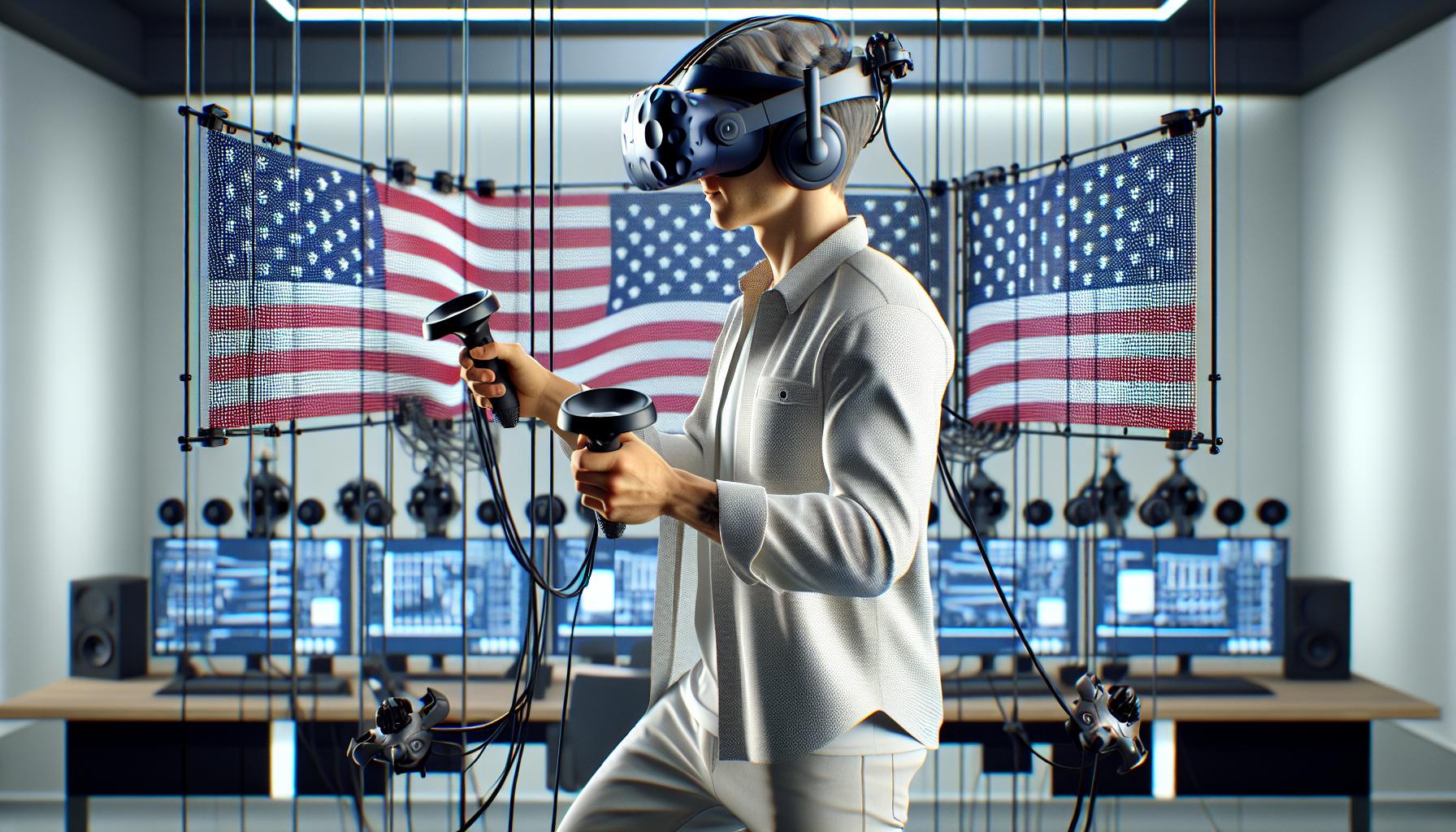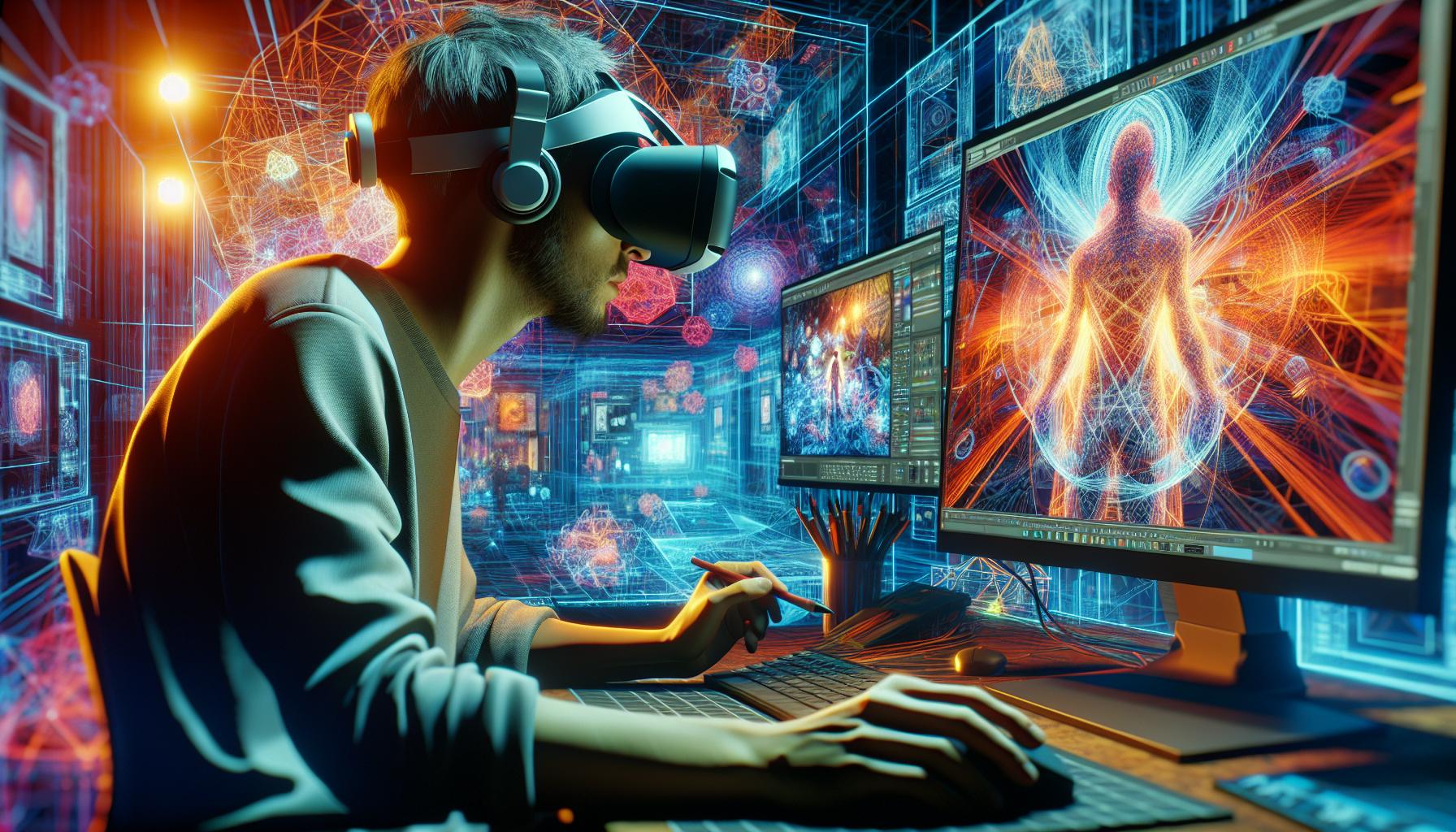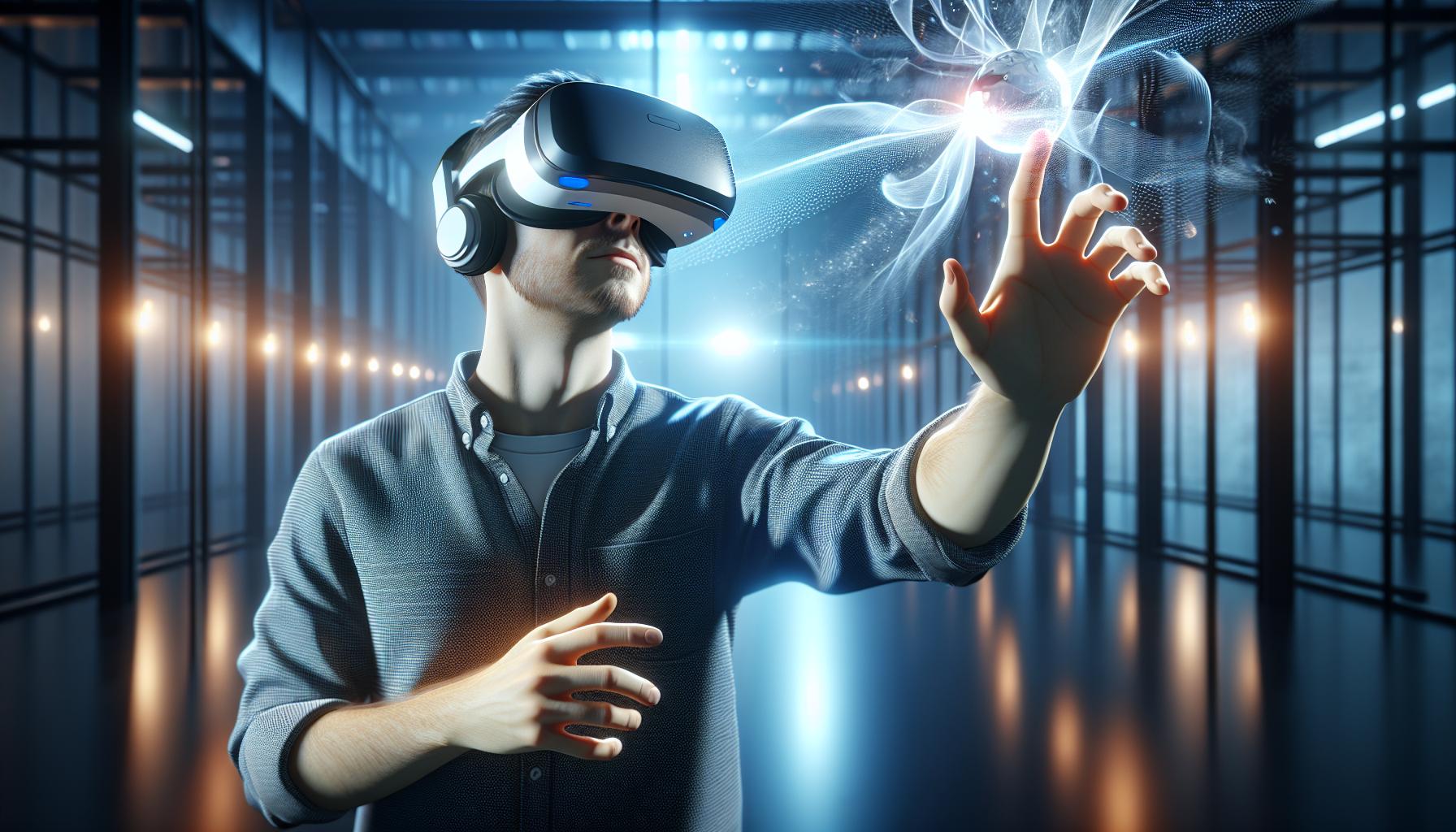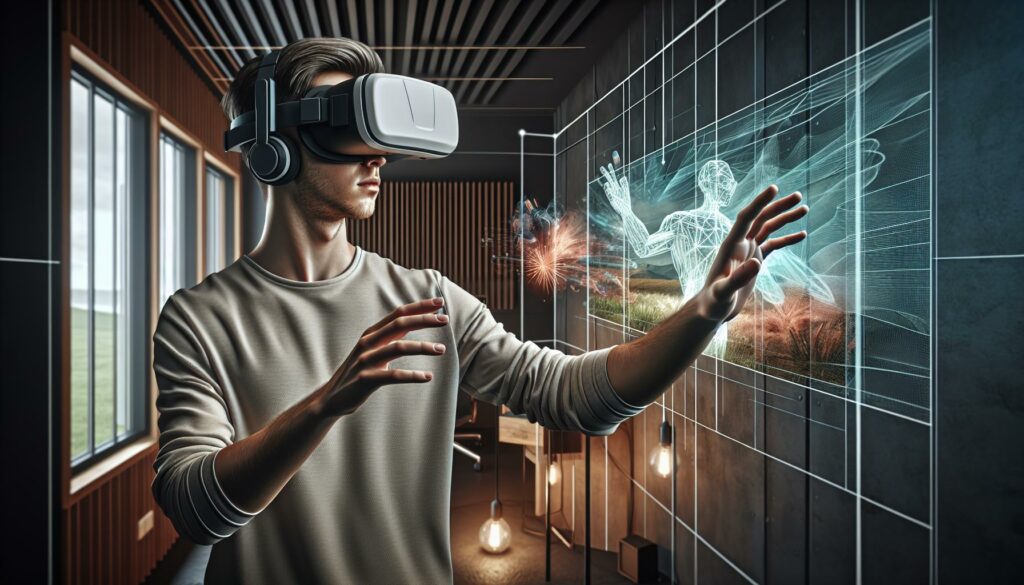Virtual reality (VR) has transformed from science fiction dreams into mind-bending reality. This groundbreaking technology whisks users away to digital realms where they can battle dragons dodge meteors or simply hang out with friends in virtual spaces – all while sitting comfortably on their couch. Virtual reality simulates a three-dimensional environment with which users can explore and interact.
As the technology continues to evolve VR’s applications extend far beyond gaming. From medical training simulations to virtual real estate tours today’s VR systems create immersive three-dimensional environments that fool our senses into believing we’re somewhere else entirely. It’s like stepping through a digital looking glass where the only limit is imagination – though you might want to clear the coffee table first to avoid any reality-checking bumps and bruises.
Virtual Reality Simulates a Three-Dimensional Environment With Which Users Can Explore and Interact.
Virtual reality simulation creates computer-generated three-dimensional environments that replicate real-world scenarios. These digital spaces enable users to navigate interactive environments through specialized hardware devices like VR headsets sensors gloves.
The core components of VR simulation include:
- Stereoscopic displays producing separate images for each eye
- Motion tracking systems monitoring head position body movements
- Input devices capturing user interactions gestures
- Spatial audio generating directional sound effects
- Haptic feedback providing tactile sensations
VR simulations process real-time data to deliver responsive experiences across multiple sensory channels:
| Sensory Channel | Simulation Method | User Experience |
|---|---|---|
| Visual | 3D Graphics | Depth perception |
| Auditory | Spatial Audio | Directional sound |
| Tactile | Haptic Feedback | Physical sensation |
| Vestibular | Motion Tracking | Position awareness |
The technology creates presence through:
- Real-time rendering of 3D graphics at high frame rates
- Low-latency tracking of user movements actions
- Physics-based interactions with virtual objects
- Synchronized audio visual haptic feedback
- Dynamic viewpoint adjustment based on head position
Modern VR simulations achieve immersion by combining high-resolution displays precise motion controls realistic physics engines. The systems respond to natural movements allowing users to look around walk grasp objects interact with virtual environments intuitively.
Key Components of Virtual Reality Systems

Virtual reality systems integrate multiple hardware elements to create immersive digital experiences. These components work together to track user movements render visual content process audio feedback.
Head-Mounted Displays (HMDs)
HMDs serve as the primary visual interface in VR systems delivering high-resolution stereoscopic images directly to users’ eyes. Modern HMDs feature dual OLED or LCD displays with refresh rates of 90Hz or higher providing crisp visuals at resolutions up to 2160 x 2160 pixels per eye. Built-in sensors monitor head position orientation while adjustable interpupillary distance settings accommodate different facial structures. Advanced HMDs incorporate eye-tracking technology cameras for mixed reality experiences integrated audio solutions.
Motion Controllers and Tracking
Motion controllers translate physical movements into virtual actions using internal accelerometers gyroscopes infrared sensors. External tracking stations or cameras monitor controller positions with sub-millimeter accuracy creating 6 degrees of freedom movement. Haptic feedback motors in controllers provide tactile responses to virtual interactions enhancing immersion. Advanced systems track individual finger movements through capacitive touch sensors optical hand tracking enabling natural object manipulation.
Spatial Audio Technology
Spatial audio creates three-dimensional soundscapes that adjust dynamically based on user head position movement. Advanced audio processing algorithms simulate sound reflection absorption properties of virtual environments. Head-related transfer functions (HRTF) customize audio output according to individual ear shapes improving directional accuracy. Binaural recording playback techniques reproduce realistic environmental sounds with precise positional tracking up to 360 degrees.
Creating Immersive 3D Environments

Virtual reality environments combine advanced graphics processing with real-time rendering to generate interactive 3D spaces. These digital worlds respond dynamically to user inputs while maintaining visual fidelity and performance.
Computer-Generated Graphics
Modern VR graphics engines create photorealistic 3D assets through advanced modeling techniques like physically based rendering (PBR) materials texture mapping. High-polygon 3D models incorporate detailed geometry mesh systems with normal maps ambient occlusion shadows for enhanced realism. Industry-standard software packages including Unreal Engine Maya 3ds Max enable artists to craft intricate virtual objects environments with precise lighting effects particle systems. Advanced shading algorithms simulate surface properties like reflectivity translucency metallic finishes creating visually compelling scenes that respond naturally to illumination changes.
Real-Time Rendering
Graphics processing units (GPUs) render complex 3D scenes at 90+ frames per second maintaining smooth visuals during user interactions. Modern rendering pipelines leverage techniques like foveated rendering dynamic level of detail optimization to maximize performance. Adaptive resolution scaling adjusts image quality based on available computing resources ensuring consistent frame rates. Advanced features including global illumination volumetric lighting ray tracing enhance visual fidelity through accurate light behavior simulation. Real-time physics engines calculate object interactions collisions fluid dynamics creating believable environmental responses to user actions.
Interactive Elements in Virtual Worlds

Interactive elements transform virtual environments into dynamic spaces where users engage directly with digital content through natural movements and intuitive controls. These elements create responsive experiences that mirror real-world interactions.
User Movement and Navigation
Virtual reality systems enable users to traverse digital spaces through multiple locomotion methods. Physical walking within room-scale VR areas provides the most natural movement experience, tracked by external sensors or inside-out tracking systems. Teleportation mechanics allow instant transportation to distant locations by pointing and clicking with motion controllers. Smooth locomotion options include joystick-controlled movement similar to traditional video games. Gesture-based navigation systems recognize hand motions to control movement direction and speed. Advanced VR platforms incorporate omnidirectional treadmills to simulate unlimited walking while remaining stationary.
Object Manipulation
Users interact with virtual objects through precise hand tracking and motion controls. Motion controllers translate physical gestures into virtual actions like grabbing, throwing, pushing or pulling digital items. Hand tracking technology enables direct manipulation of objects using natural finger movements without controllers. Physics engines calculate object behavior including weight, momentum and collision responses. Haptic feedback systems provide tactile sensations when touching or holding virtual objects. Advanced interaction systems support complex manipulations such as tool usage, object assembly and fine motor control tasks. These manipulation capabilities enable practical applications in training simulations, virtual prototyping and interactive entertainment.
Applications Across Industries
Virtual reality applications span numerous sectors, transforming traditional practices into immersive digital experiences. The technology adapts to diverse industry requirements through specialized software solutions tailored for specific use cases.
Gaming and Entertainment
The gaming industry leads VR adoption with immersive titles across multiple genres. Games like “Half-Life: Alyx” showcase photorealistic graphics while “Beat Saber” demonstrates intuitive motion controls. Virtual concerts attract global audiences, with platforms like Wave hosting performances by artists such as The Weeknd reaching 12 million viewers. Entertainment applications include virtual theme park experiences, interactive movies, and social platforms that enable users to attend events in shared digital spaces. Major studios now create VR versions of popular franchises, incorporating haptic feedback and spatial audio for enhanced immersion.
Training and Education
Educational institutions leverage VR for experiential learning environments that simulate real-world scenarios. Medical students practice surgical procedures through platforms like Touch Surgery, achieving 45% improved performance rates. Corporate training programs utilize VR to conduct safety drills, customer service simulations, and equipment operation tutorials. Virtual laboratories enable chemistry experiments without physical risks, while architectural students explore 3D building designs at full scale. Educational applications track student progress through data analytics, providing personalized learning paths based on performance metrics.
Healthcare Applications
Medical professionals employ VR for surgical planning, patient rehabilitation, and mental health treatment. Platforms like Oxford VR demonstrate 47% reduction in anxiety symptoms through exposure therapy sessions. Surgeons use anatomical visualizations for preoperative planning, reducing procedure times by 20%. Physical therapy programs incorporate VR exercises for stroke recovery, measuring patient movements with millimeter precision. Mental health applications provide controlled environments for treating phobias, PTSD, and anxiety disorders. Remote consultation platforms enable doctors to examine patients in virtual spaces, complete with 3D anatomical models and diagnostic tools.
Technical Challenges and Limitations
Virtual reality systems face several performance bottlenecks that impact user experience. High-resolution displays demand significant processing power to maintain smooth frame rates above 90 fps, creating strain on current GPU capabilities.
Latency issues manifest in three critical areas:
- Motion-to-photon delay between user movement and screen updates
- Input lag from controller actions to virtual responses
- Network latency in multiplayer VR environments
Hardware limitations present ongoing obstacles:
- Battery life constraints in wireless VR headsets last 2-3 hours
- Field of view restrictions average 100-110 degrees compared to human vision of 220 degrees
- Screen door effect from visible pixel spacing in displays
- Heat generation during extended use sessions
Physical comfort challenges affect user adoption:
- Motion sickness affects 40-70% of users during initial VR experiences
- Eye strain from prolonged focus at fixed focal distances
- Neck fatigue from head-mounted display weight averaging 470-600 grams
- Limited mobility from tethered cables in PC-based systems
- Resource-intensive 3D asset development requires specialized skills
- Real-time rendering optimizations balance visual quality with performance
- Cross-platform compatibility issues between different VR systems
- Limited standardization in development tools and frameworks
| Technical Metric | Current Limitation |
|---|---|
| Display Resolution | 2160 x 2160 per eye |
| Refresh Rate | 90-120 Hz |
| Field of View | 100-110 degrees |
| Battery Life | 2-3 hours |
| Motion-to-photon Latency | 15-20 milliseconds |
The Future of Virtual Reality Simulation
Virtual reality simulation advances rapidly with emerging technologies that enhance user immersion and interaction capabilities. Computing power increases enable photorealistic graphics rendering at higher frame rates through advanced GPUs and specialized processors. 5G networks facilitate cloud-based VR experiences with minimal latency, expanding access to high-quality content.
Haptic technology developments introduce full-body feedback suits and gloves that replicate physical sensations with precise accuracy. Eye tracking integration enables foveated rendering optimization while natural gesture recognition systems eliminate the need for controllers. Wireless solutions free users from cable constraints through enhanced data transmission protocols.
| Projected VR Advancements | Expected Timeline |
|---|---|
| 8K per eye resolution | 2024-2025 |
| Sub-5ms motion latency | 2023-2024 |
| Full body haptics | 2024-2026 |
| Brain-computer interfaces | 2025-2027 |
| Artificial touch sensing | 2023-2025 |
Mixed reality capabilities merge virtual and physical environments seamlessly through advanced spatial mapping algorithms. Neural interfaces promise direct brain-computer connections for intuitive control and enhanced sensory feedback. Artificial intelligence integration enables more responsive virtual environments with intelligent NPCs and dynamic content generation.
Miniaturization trends point toward compact yet powerful headsets that resemble standard eyewear. Social VR platforms evolve to support thousands of simultaneous users in shared virtual spaces with realistic avatars. Enterprise applications expand into collaborative design visualization remote operation training simulations.
VR Simulation
Virtual reality has emerged as a transformative technology that’s reshaping how people interact with digital environments. The combination of advanced hardware sophisticated software and intuitive controls creates immersive experiences that continue to push the boundaries of what’s possible in digital spaces. Virtual reality simulates a three-dimensional environment with which users can explore and interact.
As VR technology evolves it promises to revolutionize industries beyond gaming including healthcare education and professional training. With ongoing improvements in graphics processing haptic feedback and motion tracking the gap between virtual and physical reality continues to narrow making VR an increasingly powerful tool for both entertainment and practical applications.
The future of VR looks bright as innovations in computing power networking and user interface design pave the way for even more realistic and accessible virtual experiences. These advancements will undoubtedly open new possibilities for human interaction and digital exploration in the years to come.

